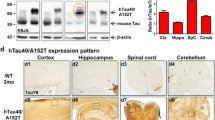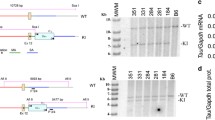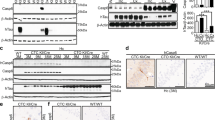Abstract
Mouse models of neurodegenerative diseases such as Alzheimer’s disease (AD) are important for understanding how pathological signaling cascades change neural circuitry and with time interrupt cognitive function. Here, we introduce a non-genetic preclinical model for aging and show that it exhibits cleaved tau protein, active caspases and neurofibrillary tangles, hallmarks of AD, causing behavioral deficits measuring cognitive impairment. To our knowledge this is the first report of a non-transgenic, non-interventional mouse model displaying structural, functional and molecular aging deficits associated with AD and other tauopathies in humans with potentially high impact on both new basic research into pathogenic mechanisms and new translational research efforts. Tau aggregation is a hallmark of tauopathies, including AD. Recent studies have indicated that cleavage of tau plays an important role in both tau aggregation and disease. In this study we use wild type mice as a model for normal aging and resulting age-related cognitive impairment. We provide evidence that aged mice have increased levels of activated caspases, which significantly correlates with increased levels of truncated tau and formation of neurofibrillary tangles. In addition, cognitive decline was significantly correlated with increased levels of caspase activity and tau truncated by caspase-3. Experimentally induced inhibition of caspases prevented this proteolytic cleavage of tau and the associated formation of neurofibrillary tangles. Our study shows the strength of using a non-transgenic model to study structure, function and molecular mechanisms in aging and age related diseases of the brain.






Similar content being viewed by others
References
Avila J, Lucas JJ, Perez M, Hernandez F (2004) Role of tau protein in both physiological and pathological conditions. Physiol Rev 84(2):361–384
Basurto-Islas G, Luna-Munoz J, Guillozet-Bongaarts AL, Binder LI, Mena R, Garcia-Sierra F (2008) Accumulation of aspartic acid421- and glutamic acid391-cleaved tau in neurofibrillary tangles correlates with progression in Alzheimer disease. J Neuropathol Exp Neurol 67(5):470–483
Bussière T, Bard F, Barbour R, Grajeda H, Guido T, Khan K, Schenk D, Games D, Seubert P, Buttini M (2004) Morphological characterization of Thioflavin S-positive amyloid plaques in transgenic Alzheimer mice and effect of passive Aβ immunotherapy on their clearance. Am J Pathol 165(3):987–995
Calissano P, Matrone C, Amadoro G (2009) Apoptosis and in vitro Alzheimer disease neuronal models. Commun Integr Biol 2(2):163–169
Chung CW, Song YH, Kim IK, Yoon WJ, Ryu BR, Jo DG, Woo HN, Kwon YK, Kim HH, Gwang BJ, Mook-Jung IH, Jung YK (2001) Proapoptotic effects of tau cleavage product generated by caspase-3. Neurobiol Dis 8:162–172
Cotman CW, Poon WW, Rissman RA, Blurton-Jones M (2005) The role of caspase cleavage of tau in Alzheimer disease neuropathology. J Neuropathol Exp Neurol 64(2):104–112
De Calignon A, Spires-Jones TL, Pitstick R, Carlson GA, Hyman BT (2009) Tangle-bearing neurons survive despite disruption of membrane integrity in a mouse model of tauopathy. J Neuropathol Exp Neurol 68(7):757–761
De Calignon A, Fox LM, Pitstick R, Carlson GA, Bacskai BJ, Spires-Jones TL, Hyman BT (2010) Caspase activation precedes and leads to tangles. Nature 464(7292):1201–1204
Dean E (2008) Apoptosis in neurodegeneration: programmed cell death and its role in Alzheimer’s and Huntington’s diseases. Eukaryon 4:42–47
Delobel P, Lavenir I, Fraser G, Ingram E, Holzer M, Ghetti B, Spillantini MG, Crowther RA, Goedert M (2008) Analysis of tau phosphorylation and truncation in a mouse model of human tauopathy. Am J Pathol 172(1):123–131
Ding H, Matthews TA, Johnson GVW (2006) Site-specific phosphorylation and caspase cleavage differentially impact tau-microtubule interactions and tau aggregation. J Biol Chem 281(28):19107–19114
Furukawa K, D’Souza I, Crudder CH, Onodera H, Itoyama Y, Poorkaj P, Bird TD, Schellenberg GD (2000) Pro-apoptotic effects of tau mutations in chromosome 17 frontotemporal dementia and parkinsonism. Ageing 11(1):57–59
Gamblin TC, Chen F, Zambrano A, Abraha A, Lagalwar S, Guillozet AL, Lu M, Fu Y, Garcia-Sierra F, LaPointe N, Miller R, Berry RW, Binder LI, Cryns VL (2003) Caspase cleavage of tau: linking amyloid and neurofibrillary tangles in Alzheimer’s disease. PNAS 100(17):10032–10037
Grundke-Iqbal I, Iqbal K, Quinlan M, Tung YC, Zaidi MS, Wisniewski HM (1986) Microtubule-associated protein tau. A component of alzheimer paired helical filaments. J Biol Chem 261:6084–6089
Grundke-Iqbal I, Iqbal K, Tung YC, Quinlan M, Wisniewski HM, Binder LI (1986) Abnormal phosphorylation of the microtubule-associated protein tau (tau) in alzheimer cytoskeletal pathology. Proc Natl Acad Sci USA 83:4913–4917
Guillozet-Bongaarts AL, Garcia-Sierra F, Reynolds MR, Horowitz PM, Fu Y, Wang T, Cahill ME, Bigio EH, Berry RW, Binder LI (2005) Tau truncation during neurofibrillary tangle evolution in Alzheimer’s disease. Neurobiol Aging 26(7):1015–1022
Hanger DP, Wray S (2010) Tau cleavage and tau aggregation in neurodegenerative disease. Biochem Soc Trans 38(4):1016–1020
Huang Y, Mucke L (2012) Alzheimer mechanisms and therapeutic strategies. Cell 148(6):1204–1222
Iqbal K, Liu F, Gong CX, Alonso ADC, Grundke-Iqbal I (2009) Mechanisms of tau-induced neurodegeneration. Acta Neuropathol 118(1):53–69
Jarero-Basulto JJ, Luna-Munoz J, Mena R, Kristofikova Z, Ripova D, Perry G, Binder LI, Garcia-Sierra F (2013) Proteolytic cleavage of polymeric tau protein by caspase-3: implications for Alzheimer’s disease. J Neuropathol Exp Neurol 72(12):1145–1161
Kaja S, Sumien N, Borden PK, Khullar N, Iqbal M, Collins JL, Forster MJ, Koulen P (2013) Homer-1a immediate early gene expression correlates with better cognitive performance in aging. Age (Dordr) 35(5):1799–1808
Kaja S, Sumien N, Shah VV, Puthawala I, Maynard AN, Khullar N, Payne AJ, Forster MJ, Koulen P (2015) Loss of spatial memory, learning, and motor function during normal aging is accompanied by changes in Brain Presenilin 1 and 2 expression levels. Mol Neurobiol 52(1):545–554
Kar A, Kuo D, He RH, Zhou J, Wu JY (2005) Tau alternative splicing and frontotemporal dementia. Alzheimer Dis Assoc Disord 19:S29–S36
Kosik KS, Joachim CL, Selkoe DJ (1986) Microtubule-associated protein tau (tau) is a major antigenic component of paired helical filaments in Alzheimer disease. Proc Natl Acad Sci USA 83:4044–4048
Kuranaga E, Miura M (2007) Nonapoptotic functions of caspases: caspases as regulatory molecules for immunity and cell-fate determination. Trends in Cell Biol 17:135–144
Liu L, Drouet V, Wu JW, Witter MP, Small SA, Clelland C, Duff K (2012) Trans-synaptic spread of tau pathology in vivo. PLoS One 7(2):e31302
Ly PT, Cai F, Song W (2011) Detection of neuritic plaques in Alzheimer’s disease mouse model. J Vis Exp 53:2831
Matthews-Roberson TA, Quintanilla RA, Ding H, Johnson GV (2008) Immortalized cortical neurons expressing caspase-cleaved tau are sensitized to endoplasmic reticulum stress induced cell death. Brain Res 1234:206–212
McIlwain DR, Berger T, Mak TW (2013) Caspase functions in cell death and disease. Cold Spring Harb Perspect Biol 5:a008656
McLaughlin B, Hartnett KA, Erhardt JA, Legos JJ, White RF, Barone FC, Aizenman E (2003) Caspase 3 activation is essential for neuroprotection in preconditioning. PNAS 100(2):715–720
Means JC, Venkatesan A, Gerdes B, Fan JY, Bjes ES, Price JL (2015) Drosophila spaghetti and doubletime link the circadian clock and light to caspases, apoptosis and tauopathy. PLoS Genet 7(11):e1005171
Morsch R, Simon W, Coleman PD (1999) Neurons may live for decades with neurofibrillary tangles. J Neuropathol Exp Neurol 58(2):188–197
Novak M, Kabat J, Wischik CM (1993) Molecular characterization of the minimal protease resistant tau unit of the Alzheimer’s disease paired helical filament. EMBO J 12(1):365–370
Pevalova M, Filipcik P, Novak M, Avila J, Iqbal K (2006) Post-translational modifications of tau protein. Bratislavské Lekárske Listy 107(9–10):346–353
Quintanilla RA, Matthews-Roberson TA, Dolan PJ, Johnson GVW (2009) Caspase-cleaved tau expression induces mitochondrial dysfunction in cortical neurons. Implications for the pathogenesis of Alzheimer’s disease. J Biol Chem 284:18754–18766
Quintanilla RA, Dolan PJ, Jin YN, Johnson GV (2012) Truncated tau and Aβ cooperatively impair mitochondria in primary neurons. Neurobiol Aging 33:619e25–619e35
Rissman RA, Poon WW, Blurton-Jones M, Oddo S, Torp R, Vitek MP, LaFerla FM, Rohn TT, Cotman CW (2004) Caspase-cleavage of tau is an early event in Alzheimer disease tangle pathology. J Clinical Invest 114(1):121–130
Rohn TT, Rissman RA, Head E, Cotman CW (2002) Caspase activation in the Alzheimer’s disease brain: tortuous and torturous. Drug News Perspect 15(9):549–557
Santa-Maria I, Hernández F, Del Rio D, Moreno FJ, Avila J (2007) Tramiprosate, a drug of potential interest for the treatment of Alzheimer’s disease, promotes an abnormal aggregation of tau. Mol Neurodegener 2(1):17
Schraen-Maschke S, Sergeant N, Dhaenens C-M, Bombois S, Deramecourt V, Caillet-Boudin M-L, Pasquier F, Maurage C-A, Sablonniere B, Vanmechelen E, Buee L (2008) Tau as a biomarker of neurodegenerative diseases. Biomark Med 2(4):363–384
Spires TL, Hyman BT (2005) Trangenic models of Alzheimer’s disease: learning from animals. NeuroRx 2(3):423–437
Spires-Jones TL, de Calignon A, Matsui T, Zehr C, Pitstick R, Wu HY, Osetek JD, Jones PB, Bacskai BJ, Feany MB, Carlson GA, Ashe KH, Lewis J, Hyman BT (2008) In vivo imaging reveals dissociation between caspase activation and acute neuronal death in tangle-bearing neurons. J Neurosci 28:862–867
Sumien N, Sims MN, Taylor HJ, Forster MJ (2006) Profiling psychomotor and cognitive aging in four-way cross mice. Age 28:265–282
Sun A, Nguyen XV, Bing G (2002) Comparative Analysis of an improved thioflavin-S stain, gallyas silver stain, and immunohistochemistry for neurofibrillary tangle demonstration on the same sections. J Histochem Cytochem 50(4):463–472
Turk B, Stoka V (2007) Protease signaling in cell death: caspases versus cysteine cathepsins. FEBS Lett 581:2761–2767
Urbanc B, Cruz L, Le R, Sanders J, Ashe KH, Duff K, Stanley HE, Irizarry MC, Hyman BT (2002) Neurotoxic effects of thioflavin S-positive amyloid deposits in transgenic mice and Alzheimer’s disease. Proc Natl Acad Sci USA 99(22):13990–13995
Wray S, Lewis PA (2010) A tangled Web: tau and sporadic Parkinson’s disease. Front Psychiatry 1:150
Xie A, Gao J, Xu L, Meng D (2014) Shared mechanisms of neurodegeneration in Alzheimer’s disease and Parkinson’s disease. BioMed Res Int 2014:1–8
Zhang Q, Zhang X, Chen J, Miao Y, Sun A (2009) Role of caspase-3 in tau truncation at D421 is restricted in transgenic mouse models for tauopathies. J Neurochem 109(2):476–484
Acknowledgments
Research reported in this publication was supported in part by Grants AG022550, AG027956 (NS, PK), AG010485 from NIH/NIA, RR022570 and RR027093 from NIH/NCRR and EY022774 from NIH/NEI (PK). The content is solely the responsibility of the authors and does not necessarily represent the official views of the National Institutes of Health. Additional support by the Felix and Carmen Sabates Missouri Endowed Chair in Vision Research, the Vision Research Foundation of Kansas City and a departmental challenge grant by Research to Prevent Blindness (PK) is gratefully acknowledged. The authors thank Michael J. Forster, Margaret, Richard and Sara Koulen for generous support and encouragement.
Author information
Authors and Affiliations
Corresponding author
Additional information
John C. Means and Bryan C. Gerdes contributed equally to this work.
Electronic supplementary material
Below is the link to the electronic supplementary material.
11064_2016_1942_MOESM1_ESM.tif
Young behaviorally impaired mice have cleaved tau expression and caspase activity. (a-c) Young mice that have truncated tau (cTAU) (normalized to actin) (a) and increased caspase activity (normalized to buffer) (b) also have a weaker learning index (below red line) (c), but no difference in the latency to fall (d). In contrast, aged mice that exhibit normal behavior do not express cleaved tau (a) or active caspase (b). Green squares represent young mice, blue triangles represent aged mice. Individual values above the red line indicate detectable expression of cleaved tau and higher caspase activity. Every point above the red line in panel a has detectable cleaved Tau expression. In panel b, every point above the red line represents the same points in panel a that are above the red line. In panel c, the red line is set at the half-maximal value for the learning index (TIFF 293 kb)
11064_2016_1942_MOESM2_ESM.tif
Increased caspase activity positively correlates with cleaved tau expression in the forebrain. (a) Quantitative densitometry indicated that cleaved tau (cTAU) expression (normalized to actin) is significantly greater in the forebrain of aged mice compared to the cerebellum (P < 0.0001, R2 = 0.4255).(b) Similarly, aged mice also have higher caspase activity (normalized to buffer) in the forebrain compared to the cerebellum, measured using the caspase substrate DEVD-afc (P = 0.0020, R2 = 0.6710).(c) Correlation analysis revealed that the increased caspase activity significantly correlates with increased cleaved tau expression in the forebrain of aged mice (P < 0.0001, R2 = 0.6338). Linear regressions are shown as solid lines; dotted lines represent 95 % confidence intervals. Circles represent individual forebrains, squares represent individual cerebellum for panels a and b. Squares represent young individuals, triangles represents aged individuals for panel c (TIFF 252 kb)
Rights and permissions
About this article
Cite this article
Means, J.C., Gerdes, B.C., Kaja, S. et al. Caspase-3-Dependent Proteolytic Cleavage of Tau Causes Neurofibrillary Tangles and Results in Cognitive Impairment During Normal Aging. Neurochem Res 41, 2278–2288 (2016). https://doi.org/10.1007/s11064-016-1942-9
Received:
Revised:
Accepted:
Published:
Issue Date:
DOI: https://doi.org/10.1007/s11064-016-1942-9




